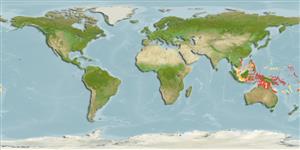Environment: milieu / climate zone / depth range / distribution range
Ecología
marino; agua dulce; salobre bentopelágico; anfidromo. Tropical; 19°N - 21°S
Western Pacific: Yaeyama Islands (Japan) south to Queensland (Australia) and east to New Caledonia.
Tamaño / Peso / Age
Maturity: Lm ? range ? - ? cm
Max length : 30.0 cm SL macho / no sexado; (Ref. 44894)
Espinas dorsales (total): 12; Radios blandos dorsales (total): 10-11; Espinas anales 3; Radios blandos anales: 8 - 9
Adults inhabit inshore areas near mangroves. Occur in lentic and lotic freshwater (Ref. 7300). Juveniles commonly found in the lower sections of creeks and may penetrate several kilometers into fresh water (Ref. 2847, 44894). Omnivore. Eggs are guarded and fanned by the male parent (Ref. 205).
Life cycle and mating behavior
Madurez | Reproducción | Puesta | Huevos | Fecundidad | Larva
Eggs are guarded and fanned by the male parent (Ref. 205).
Paxton, J.R., D.F. Hoese, G.R. Allen and J.E. Hanley, 1989. Pisces. Petromyzontidae to Carangidae. Zoological Catalogue of Australia, Vol. 7. Australian Government Publishing Service, Canberra, 665 p. (Ref. 7300)
IUCN Red List Status (Ref. 130435)
Threat to humans
Harmless
Human uses
Pesquerías: escaso valor comercial
Más información
ReferenciasAcuiculturaPerfil de acuiculturaRazasGenéticaElectrophoresesheritabilidadEnfermedadesProcesamientoNutrientsMass conversion
ColaboradoresImágenesStamps, Coins Misc.SonidosCiguateraVelocidadTipo de nataciónSuperficie branquialOtolitosCerebrosVisión
Herramientas
Special reports
Download XML
Fuentes de Internet
Estimates based on models
Preferred temperature (Ref.
123201): 26.4 - 29, mean 28 °C (based on 344 cells).
Phylogenetic diversity index (Ref.
82804): PD
50 = 0.5312 [Uniqueness, from 0.5 = low to 2.0 = high].
Bayesian length-weight: a=0.01660 (0.00638 - 0.04320), b=2.99 (2.76 - 3.22), in cm total length, based on LWR estimates for this (Sub)family-body shape (Ref.
93245).
Nivel trófico (Ref.
69278): 4.0 ±0.67 se; based on food items.
Resiliencia (Ref.
120179): Medio, población duplicada en un tiempo mínimo de 1.4-4.4 años (Preliminary K or Fecundity.).
Fishing Vulnerability (Ref.
59153): Low to moderate vulnerability (27 of 100).
Nutrients (Ref.
124155): Calcium = 116 [65, 207] mg/100g; Iron = 0.805 [0.471, 1.486] mg/100g; Protein = 17.9 [16.9, 18.9] %; Omega3 = 0.171 [0.084, 0.337] g/100g; Selenium = 33.6 [16.8, 70.3] μg/100g; VitaminA = 27.3 [9.0, 75.2] μg/100g; Zinc = 1.3 [0.9, 2.0] mg/100g (wet weight);
